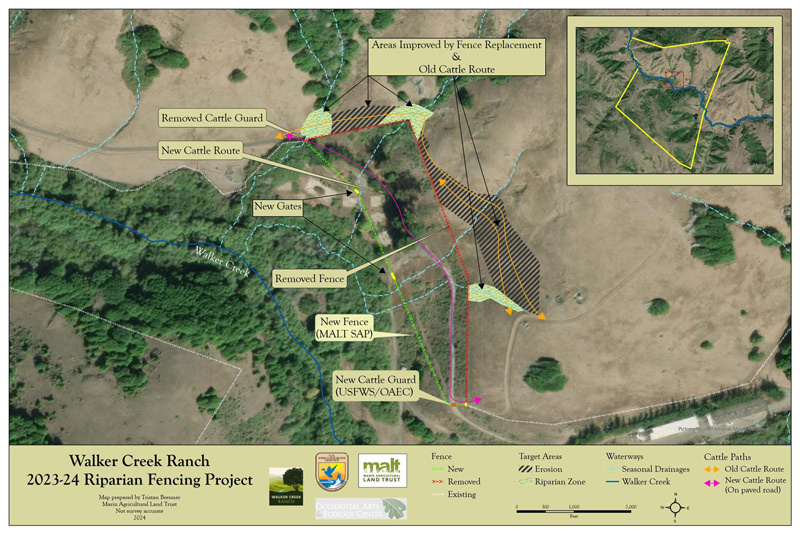Walker Creek Ranch Makes Strides for Coho Salmon Recovery

By Tristan Brenner,
Stewardship Program Manager
June 13, 2024
The fight to save the iconic coho salmon in Marin County’s Walker Creek is gaining ground thanks to collaborative conservation efforts. For the first time in decades, there is real hope for reviving the struggling fish populations.
“We’re making excellent progress restoring critical salmon habitat in Walker Creek,” said Kris Jacobsen, assistant manager of the 1,720-acre MALT-protected Walker Creek Ranch. “By relocating a degraded fence away from the riparian zone, we prevented tons of sediment from eroding into the creek. This simple land management change will allow native vegetation to re-establish and stabilize the soil.”
Once Abundant, Now on the Brink
For millennia, coho salmon have been returning to the cool waters of Walker Creek in central Marin County to lay their eggs in the safety of the freshwater and usher in the next generation. Not long ago, it was difficult to drive a horse and buggy across the creek at the height of the winter salmon run because of the numbers of fish in the shallow water.
But things have changed dramatically in the last two centuries. Habitat destruction, overfishing, water pollution and climate change have pushed this species to its very edge and they are now listed as a federally endangered species. The fate of this iconic species now rests in our hands, and in the ranching community that tends to much of the Walker Creek watershed.
Big Improvement for the Walker Creek Ranch
Earlier this year, Kris and the ranching tenant at Walker Creek Ranch, an active cattle ranch and outdoor education center run by the Marin County Office of Education, made significant strides in improving the health of their land.
Thanks to strategic use of funding from the Marin Agricultural Land Trust’s (MALT) Stewardship Assistance Program and the U.S. Fish and Wildlife Service (administered by the Occidental Arts and Ecology Center), the ranch replaced a degraded fence that had been funneling cattle through creek habitat causing erosion and the deposition of fine sediment into the main channel of Walker Creek. A simple change to how this fence lays across their land will not only mitigate erosion but also facilitate better pasture management, allowing native vegetation to recover and ultimately help stabilize the soil.
“This is exactly the type of stewardship that is increasing salmon populations in the watershed,” shared Nancy Scolari, the executive director of the Marin Resource Conservation District (MRCD). The MRCD has led the restoration efforts for this watershed, developing the comprehensive Walker Creek Watershed Enhancement Plan that outlines the actions needed to address key issues such as erosion control, water quality improvement, and habitat restoration.

Part of the complexity in conserving these fish are their dependence on the entire watershed’s health for their survival—from the highest reaches of the creek to the still waters of the Pacific-facing estuaries. As Nancy further shared “Stewarding this species’ spawning grounds requires a multi-faceted approach across the entire landscape. For us to succeed, we have to come together as a community.”
MALT’s work protecting private farm and ranchland is a key piece in this collective recovery effort. Each acre of land conserved in MALT easements builds upon the region’s growing network of protected land. Through more than four decades of conservation efforts, MALT has helped conserve the majority of the Walker Creek watershed—from its mouth in Tomales Bay to its headwaters in Hicks and Chileno valleys.
But protecting the land is just the beginning, proactive land stewardship is essential to revitalize this landscape for the benefit of our ranching community and the health of our local ecosystem. “We’re seeing great progress in Walker Creek,” Nancy said “it’s a testament to the commitment of our ranching community and the value of us all working together.”
—————
U.S. Fish and Wildlife Service – Coastal Program
The U.S. Fish and Wildlife Service (USFWS) Coastal Program focuses on the conservation and restoration of coastal ecosystems in the United States. By collaborating with local communities, governmental agencies, and non-profit organizations, the program aims to protect critical habitats, support wildlife diversity, and enhance the resilience of coastal areas against climate change. Efforts include habitat restoration projects, invasive species management, and public education initiatives, all designed to maintain the health and sustainability of coastal environments.